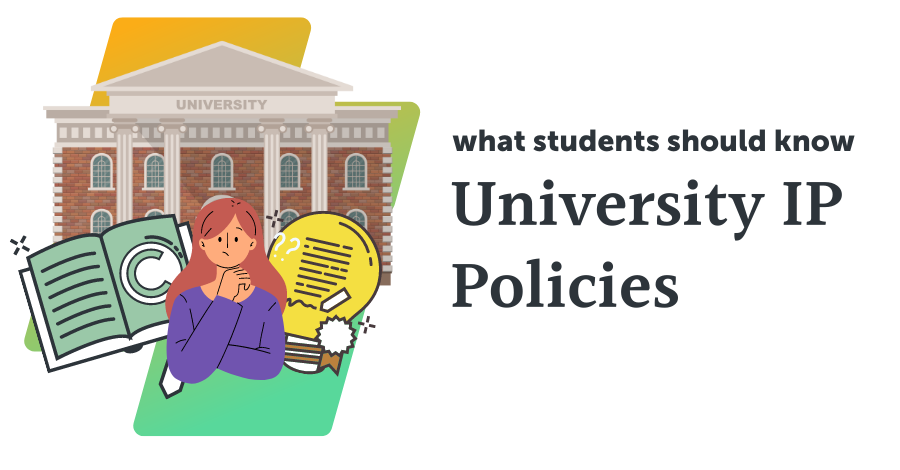Colleges and universities can be creative environments in which ideas, concepts and innovation come to life. However, what happens when parties want to protect their intellectual property? Who owns the work, and who shares in any generated profits? There are a number of important aspects of a university’s intellectual property policy of which students should be aware.
University Intellectual Property Policy: What is it?
At a high level, a university intellectual property policy is a formalized document which establishes and clarifies ownership rights, as well as usage, monetization, and management of IP that has been created by students, faculty, and others associated with the university. More specifically, a comprehensive university IP policy will cover topics such as the types of IP covered, how it affects students working in conjunction with the university on research, what can and cannot be disclosed to others (confidentiality), and most other aspects on how IP is addressed within the university.
Goals of a University IP Policy
According to the World Intellectual Property Organization, the primary goals for a university to implement an IP policy include:
- Provide legal certainty.
- Promote scientific research and technological development.
- Encourage researchers to consider the possible opportunities for exploiting an invention so as to increase the potential flow of benefits to society.
- Provide an environment that supports and encourages innovation and development.
- Balance the various conflicting interests of universities, industry and society.
- Ensure compliance with applicable national laws and regulations.
Important Aspects of an IP Policy for Students
Students should pay close attention to various aspects of their university’s IP policy. For example, students should have a clear understanding of who owns intellectual property created while attending the university. It is also important to note that at quite a few colleges and universities, undergraduate students are treated differently than graduate students/researchers in regards to any IP they produce. Brown University’s Patent & Invention Policy, for instance, spells out when the university “does not assert any ownership interest in undergraduate intellectual property. In particular, it clarifies intellectual property issues relating to industry-related capstone projects”.
The University of Notre Dame’s policy, on the other hand, asserts that all intellectual property “arising from University Work” is owned by the university. It also provides a definition of “University Work,” which not only includes research and development activities, but work that is “conducted with Substantial Use of University resources, consistent with the University’s Conflict of Commitment Policy.” Generally speaking, this does not include a student’s coursework, but the statement is very broad (and is pretty much standard language on many university IP policies). While the policy also includes a section on when the University will waive its rights, students should ensure clarification on the type of ownership they have over their creative works.
IP Policies Regarding Licensing
Universities who have the right to license intellectual property created by students or researchers may not always exercise this right. This allows the creator to move forward with licensing on their own. Students should be aware of when they may exercise this option.
Much like Cuba Gooding’s character in the movie “Jerry MaGuire”, there is a Show Me the Money aspect to a university’s IP policy. If the university is filing the necessary documents to protect the IP, students should understand what they could receive in the form of compensation. For example, Boston University’s IP Policy provides a straightforward Royalties policy in section IV(E). The policy provides the inventor/author with 1/3rd of the net proceeds from the sale or licensing of IP. The university will deduct its costs from the gross proceeds. Costs can include many things – marketing, litigation, filing fees and registration, and production. Students should understand these costs and ensure they are receiving the proper amount of compensation.
Exceptions and Exclusions
University IP policies can be tricky to understand. There may be exceptions and exclusions. As noted above, many of these policies start out as a “blanket” policy in which the university owns works created with university resources, and then the policy will carve out rules for scenarios such as student coursework, third party projects and other more specific situations. It is often advisable for students to engage an attorney to be clear that their rights are understood. Litigation can be costly, so it is best to review and clarify everything before signing any agreement.
Where to Find University IP Policies
Most major universities will have their IP policy available on the policies section of their public websites, usually with other similar documents. Here are some major university IP policies you can browse:
Carnegie Mellon University: https://www.cmu.edu/policies/administrative-and-governance/intellectual-property.html
University of California: https://www.ucop.edu/research-policy-analysis-coordination/policies-guidance/intellectual-property/index.html
Stanford University: https://doresearch.stanford.edu/policies/research-policy-handbook/intellectual-property
Do you see any similarities between them? Any major differences?
_________
 The Michelson Institute for Intellectual Property, an initiative of the Michelson 20MM Foundation, provides access to empowering IP education for budding inventors and entrepreneurs. Michelson 20MM was founded thanks to the generous support of renowned spinal surgeon Dr. Gary K. Michelson and Alya Michelson. To learn more, visit 20mm.org.
The Michelson Institute for Intellectual Property, an initiative of the Michelson 20MM Foundation, provides access to empowering IP education for budding inventors and entrepreneurs. Michelson 20MM was founded thanks to the generous support of renowned spinal surgeon Dr. Gary K. Michelson and Alya Michelson. To learn more, visit 20mm.org.
